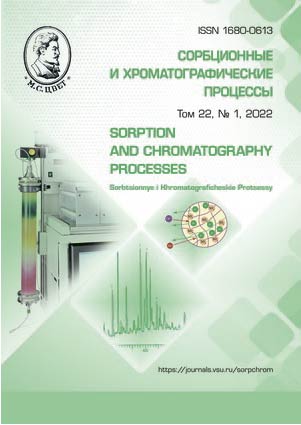Express method to determine volatile organic impurities in alcoholic distilled beverages based on a combination of GC/FID and GC/MSD
Abstract
This study was motivated by the inadequate development of instrumental methods for the high precision and reliable identification of the chemical composition of alcoholic beverages. In this work, we carried out the simultaneous selective identification of 20 chemical compounds most characteristic of distilled beverages. The methods of gas chromatography with flame ionization detection and gas chromatography-mass spectrometry were used. We selected the following conditions for the chromatographic separation and mass spectrometric detection of volatile organic impurities in alcoholic beverages: injected sample volume of 0.7 µl, helium as a carrier gas, injector temperature of 150°C, thermostat temperature of 75°C, temperature programming to 220°C, ion source temperature of 230°C. Mass spectra were registered in SCAN mode in the mass (m/z) range of 19-600 a.m.u. The components were identified by comparing the obtained experimental spectra with library data. To assess the matrix effect, we conducted a series of experiments using real samples of alcoholic beverages. We did not observe any retention time drift caused by repeated sample injections, and the coefficient of variation did not exceed 3%, suggesting no matrix effect. We created a user library called Whiskey 22, which provided standard conditions for recording mass spectra. This allowed us to record highly similar spectra for the same compounds using different instruments. This advantage increases the reliability of identification. The study revealed and experimentally confirmed the possibility of using a gas chromatograph with mass spectrometric detection for the selective identification of volatile organic compounds in alcoholic beverages. The developed methodical approach is universal and applicable for research into the chemical composition of grain distillates, whisky, rum, rum distillates, tequila, and moonshine. The advantages of new approach include: simultaneous selective determination of 20 components in 19 min., no sample preparation, rapidity, sufficient reproducibility, high identification accuracy, no column conditioning between sample waters, and it can be used for routine analysis. The prospect of the developed approach is the possibility to use it as a reference technique in the analysis of the quality and safety of alcohol beverages by gas chromatography with flame ionization detection.
Downloads
References
Garkusha M.V Polozhishnikova M.A., Tovaroved prodovolstvennyx tovarov, 2013, Vol. 10, pp. 23-27.
Muratshin A.M., Partnery i konkurenty, 2001, Vol. 11, pp. 30-33.
Shelekhova N.V. Shelekhova T.M. Skvorcova L.I. et al., Pishhevaya promyshlennost, 2019, 4, pp. 117-118.
Rudakov O.B., Laboratoriya i proizvodstvo, 2018, Vol. 1(1), pp. 120-132.
Shelexova N.V. Polyakov V.A., Pivo i napitki, 2017, Vol. 1, pp. 34-36.
Zolotov Yu.A. Revelskij I.A., Zhurnal analiticheskoj khimii. 2018, Vol. 73, No 8, pp. 646-648.
Yashin Ya.I., Yashin A.Ya., Sorbtsionnye khromatograficheskie protsessy, 2014, Vol. 14, No 2, pp. 203- 213.
Logutov V.I. Detektory dlya gazovyx xromatografov. Vybor detektora podgo-tovka k rabote i ocenka sostoyaniya xroma-tografa po osnovnym xarakteristikam detektora. Nizhnij Novgorod. Natsionalnyj is-sledovatelskij Nizhegorodskij gosudarstvennyj universitet im. N.I. Lobachevskogo, 2017, 52 p.
Handbook of Alcoholic Beverages Technical Analytical and Nutritional As-pects. ed. A.J. Buglass. John Wiley Sons. Ltd., 2011, 1204 p.
Nikitina S.Yu. Shaxov S.V. Pylnyj D.V. et al., Pishhevaya promyshlennost, 2018, No 6, pp. 56-60.
Shelekhova N.V. Shelekhova T.M. Skvorcova L.I. et al., Pishhevaya promyshlennost, 2020, 6, pp. 52-56. DOI 10.244110235-2486-2020 -10066.
Zaikin V.G. Borisov R.S., Mass-spektrometriya, 2021, Vol. 18, No 1, pp. 4-31.
Samoxin A.S. Revelskij A.I. Chepelyanskij D.A. et al., Mass-spektrometriya, 2011, Vol. 8, No 1, pp. 65-67.
Samoxin A.S. Revelskij I.A., Analitika i control, 2012, Vol. 16, No 3, pp. 269-274.
NIST 20 (2020) Mass Spectral Library (NISTEPANIH EI MS Library 2020 Release). SoftwareData Version NIST Stand-ard Reference Database. Number 69. May 2020. National Institute of Standards and Technology. Gaithersburg. MD 20899 httpwebbook.nist.govchemistry (data obrashheniya 01.12 2021)
Nikitina S.Yu., Rudakov O.B., Grigorev A.M. Proizvodstvo spirta i likyo-rovodochnyx izdelij, 2013, No 4, pp. 38-41.
Ng L.K., Analytica Chimica, 2002, Vol. 465, pp. 309-318.
Lebedev A.T., Mass-spektrometriya dlya analiza obektov okruzhayushhej sredy, M., Texnosfera, 2013, 632 p.
Silverstein R.M., Morril T., Bassler C. Spectrometric identification of organic com-pounds, John Wiley Sons. 1991. 475 p.
Savchuk S.A. Nuzhnyj V.P. Rozhanec V.V. Khimiya i toksikologiya etilovogo spirta i napitkov izgotovlennyx na ego os-nove. Xromatograficheskij analiz spirtnyx napitkov. M., Lenand. 2017. 184 p.
Brazier I.L., Forensic applications of mass-spectrometry, 1995, pp. 259-289.
Pyckij I.S. Kuznecova E.S. Buryak A.K., Sorbtsionnye i khromatograficheskie protsessy, 2021, Vol. 21, No 1, pp. 69-76.
McLafferty F.W. Stauffer D.B., Mass Spectrometry, 1984, Vol. 58, pp. 139-149.
Watson D.G., Mass Spectrometry, 2018, Vol. 3, No 5, pp. 607-629.
Zolotov Yu.A., Zhurnal analiticheskoj khimii, 2021, Vol. 76, No 1, pp. 5-19.
Becker J.S., Inorganic mass spectrometry. Principles and Applications, Wiley In-terscience, 2008, 518 p.
Lebedev A.T. Mass-spektrometriya v organicheskoj khimii, M., Binom. Laboratoriya znanij, 2003, 493 p.
Zaikin V.G. Borisov R.S., Mass-spektrometriya, 2021, Vol. 18, No 1, pp. 4-31.
Muratshin A.M. Galkin E.G. Nigmatullin A.T. et al., Opredelenie proisxozhdeniya etilovogo spirta metodom xro-mato-mass-spektrometrii. Rezhim dostupa httpfromserge.narod.rumetod_khromato-mass-spektrometrii.pdf(data obrashheniya 03.12.2021).







